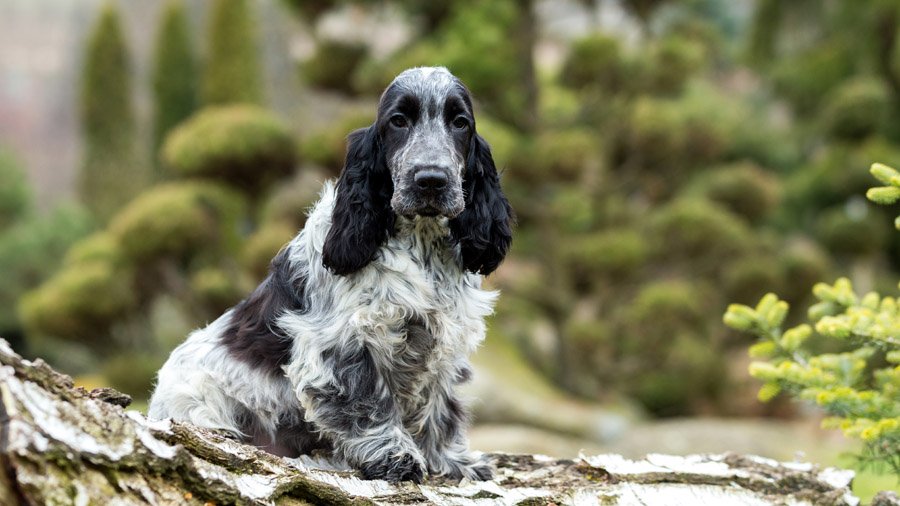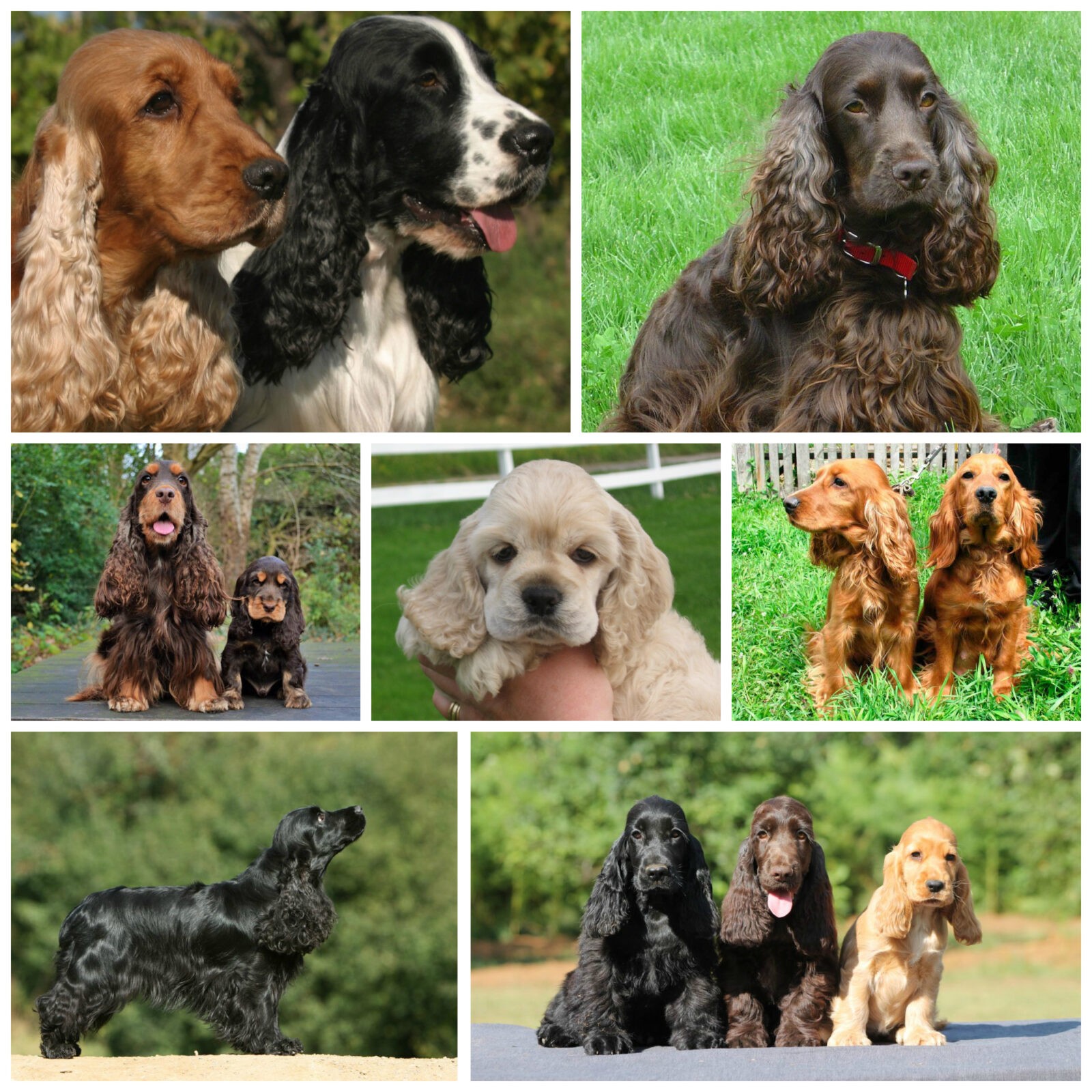About such a breed of dog as the English Cocker Spaniel first became known at the beginning of the 20th century, and work on its breeding began in the 1880s. From the name of the breed it is clear that England is the birthplace of English Cockers. Often, however, English Cocker Spaniels are confused with their American brethren - these breeds are similar, but differ somewhat in the exterior. Calling English Cockers - gun hunting for swamp and field game, although these dogs quickly adapt to almost any role. It is not without reason that English urban cockers are bred as companion dogs, which is not surprising, given their good-natured nature, healthy curiosity and a high degree of accommodating with other pets.

Brief description of the Cocker Spaniel breed
These animals are perfectly trainable, can be started even by inexperienced owners. Unpretentious in care, they can live both in a street aviary and in a small city apartment - their good endurance and modest dimensions allow this (the weight of the dogs is from 12.5 to 15 kg, height - 38-41 cm). English Cocker Spaniels are excellent human companions, meeting almost every desire of a potential owner. - they are ready to hunt without damaging the prey, they are affectionate and playful, able to adapt to the mood of the owner.
The main distinguishing features of the English Cocker Spaniels - long hanging ears, decorated with wavy hair, developed muscles, large paws, allowing you to get trophies while hunting from the water. The head of the English Cocker is domed, medium in size, the transition from the forehead to the muzzle is smooth and well defined. The eyes are predominantly dark brown in color, oval in shape, with close-fitting eyelids. The ears are set low, long, close to the head tightly, which does not negatively affect the quality of the hearing of the animal. The nose is moderately large, dark, crowning a fairly elongated muzzle (unlike American Cockers, the muzzle of the British cannot be shortened). The bite of strong developed jaws is scissor-like. The neck is rather long and muscular. The strong body is moderately short, straight, convex in the lumbar region, the chest is deep, the stomach is tucked up. The limbs are distinguished by bony, well-developed muscles, the paws are large, with large fingers. The tail is set slightly below the level of the back, most often docked. The coat of the English Cocker Spaniel is long (sometimes curly) on the legs, ears and flanks. The undercoat is well developed. Shades of wool - black, brown, red, golden, black and white, red and white, brown and white (sometimes with tan or speck).
basic information
| Breed name: | Cocker Spaniel |
| Country of origin: | United Kingdom |
| The time of the birth of the breed: | XIV century |
| Type of: | retrievers, spaniels and water dogs |
| The weight: | 12 - 15 kg |
| Height (height at the withers): | 38 - 41 cm |
| Life Expectancy: | 12 - 15 years old |
|
ICF classification:
|
Group 8, Section 2, Number 5 |
| Puppies price: | 200 – 900 $ |
| Most popular nicknames: | list of nicknames for cocker spaniel |
Evaluation of the characteristics of the Cocker Spaniel breed
| Adaptability
(a definition meaning how easily a dog can adapt to changes in life) |
🐶🐶🐶🐶🐶 |
| Shedding level
(Level and frequency of hair loss in the animal) |
🐶🐶🐶 |
| Tenderness level
(The level and amount of tenderness and affection that the dog gives in return for attention to itself) |
🐶🐶🐶🐶🐶 |
| Exercise needs
(Dog's daytime activity level) |
🐶🐶🐶🐶 |
| Social need
(The required number of contacts of the dog with other animals, as well as people) |
🐶🐶🐶🐶🐶 |
| Apartment content
(A factor that determines the level of noise and other inconveniences that a dog can deliver to owners in relation to the size of the apartment to the size of the dog) |
🐶🐶🐶🐶🐶 |
| Grooming
(The number of bathing, brushing, and the number of professional grooming sessions required for the dog) |
🐶🐶🐶🐶🐶 |
| Friendliness in an unfamiliar environment
(Features of the behavior of a dog in a society with strangers or in an unfamiliar environment) |
🐶🐶🐶🐶🐶 |
| Tendency to bark
(Tendency to bark and its frequency and volume) |
🐶🐶🐶🐶 |
| Health issues
(Potential health status of the dog) |
🐶🐶🐶🐶 |
| Territoriality
(The dog's tendency to protect his home, yard, or even his owner's car) |
🐶🐶🐶 |
| Friendliness to cats
(The tendency towards tolerance for cats and decreased manifestation of hunting instincts) |
🐶🐶🐶 |
| Intelligence
(The ability of the dog to think and solve emerging difficulties (not to be confused with learning!) |
🐶🐶🐶🐶🐶 |
| Education and training
(The level of difficulty in training the dog to perform certain actions) |
🐶🐶🐶🐶🐶 |
| Friendliness to children
(A factor that determines how friendly a dog is to children, whether he likes to play with them and tolerate some childish pranks) |
🐶🐶🐶🐶🐶 |
| Game activity
(The concept is determined by its very name, and, as a rule, is found in almost all dogs) |
🐶🐶🐶🐶 |
| Observation
(The ability of a dog to detect the presence of a stranger on its territory) |
🐶🐶🐶 |
| Friendliness to other dogs
(The tendency of the dog to find common language with his other relatives) |
🐶🐶🐶🐶 |
Cocker Spaniel photo:
Origin story
The character of the cocker spaniel
Maintenance and care
The coat of a Cocker Spaniel varies. Thick, sometimes wavy short hair adorns this dog. The color is mostly monochromatic. It can be black and light cream, and sometimes even reddish brown. There are also spotted spaniels (two or more colors). Cocker Spaniels need intensive and systematic grooming. Most owners of these dogs prefer to resort to the help of professionals who can not only clean the coat, but cut it, buy a dog. It is best to carry out this procedure once every two months. Note that the cost of such services in different salons may be different.
Many Cocker Spaniel owners prefer to keep their pets short. This makes it easier to take care of your dog in general. But even in this case, you will have to cut the dog's hair and nails every two months, as well as thoroughly bathe the dog. Grooming in dogs of this breed should begin immediately upon reaching the coat of the appropriate size. It is best to accustom to a haircut and regular combing from an early age. This will teach your pet to the procedure from childhood. The same goes for trimming your nails and brushing your teeth. Try to accustom the dog to all hygiene procedures from the first days of the appearance of the puppy in the house. Unfortunately, Cocker Spaniels are distinguished by their negative attitude towards grooming. Therefore, it is best to get extensive advice on this issue from a veterinarian.
Nails should be trimmed every month, ears checked weekly. When examining the ears, look for irritation, inflammation, and any signs of infection, which may manifest as foul odor from the ears. This procedure is important, as Cocker Spaniels are prone to various ear diseases of an infectious nature. To prevent ear problems, treat your pet's ears with a special solution weekly. During feeding it is necessary to use narrowed bowls. This will prevent the ears from getting into the food while eating. The same applies to drinkers. Some Cocker owners even put their dogs on a leash while eating to prevent their ears from getting caught in the food.
Training and education of cocker spaniels
English Cocker Spaniels are easy to train, but the training and education system should include rewards and praise. Cocker spaniels are very sensitive, so any rudeness and aggression should be completely excluded during training. Otherwise, your lessons will fail. The best in training - this is the reward and praise of the animal for any, even insignificant, success.
If a baby cocker is acquired as a family friend, then the best option as a training would be to take an OKD course, during which the dog learns the commands: “next”, “place”, “come to me”, “sit”, “no” and others . Moreover, the natural qualities of English spaniels (in the field of training) are so well developed that both a professional and a beginner can teach them the basics of training. Main - do not show excessive affection during classes. The Cocker Spaniel, having figured out that the owner is too soft, will either become stubborn, following commands, or try to ignore the words of the person. As a reward during training, a calm and friendly tone is used (usually they say to the dog: “Well done!”) And a treat. Punish the dog with a strict tone of voice. In rare cases, the animal can be lightly hit on the rump with a hand, twig, or newspaper without causing pain.
Since English Cocker Spaniels are hunters, after completing the OKD course at about 7-9 months they are trained (at the request of the owner). From childhood, these dogs are taken with them during outings into nature. From childhood, the spaniel will become accustomed to the area where game hunting will take place in the future. Typically, English Cockers are used as assistants in gun hunting for upland, swamp, field and waterfowl game. At first, the animal can be accustomed to the sound of a hunting horn (sometimes a whistle), for example, by giving food, accompanying the action with a signal. So the dog will not only not be afraid of the characteristic sound, but will also understand when to approach the owner. Also, from an early age, a pet is taught to develop instincts - they hide an object (a toy, a treat) first on the lower shelves of the closet, under the bed, for example. Gradually the task becomes more difficult - the thing you are looking for lies higher and higher, and the windows are open - this makes it harder for the dog to recognize exactly where the desired is. Gradually, the animal is taught to catch the great snipe (this bird flies low and allows periodic landings), ducks, pheasants, corostels, snipes, quails, partridges. To begin with, the dog should be allowed to smell the bird, and then move away from it, pointing in the right direction to its location. As a rule, these dogs quickly learn the basics of training, which allows them to become good hunters at a young age.
Health and disease of cocker spaniels
Some interesting facts
- Cocker Spaniel - this is an affectionate, gentle and well-mannered pet that is suitable for keeping in any home.
- Cocker Spaniels - These are companion dogs, so they should live exclusively in the house with the owner.
- The character and physiological development of the spaniel will largely depend on the professionalism of the breeder. Therefore, it is necessary to purchase a dog from experienced and proven dog breeders.
- The Cocker Spaniel takes part in various competitions with pleasure: hunting, running, search competitions, etc.
- The Cocker's tail is usually docked in the first days of life, but dog breeders differ on this point. Many people prefer to leave the tail undocked.
- During training, you should thank dog and delight her with treats.
Nurseries and breeders
We borrowed material from the wonderful site of our partners DOGCATFAN.COM about cats and dogs, the author dogcatfan

